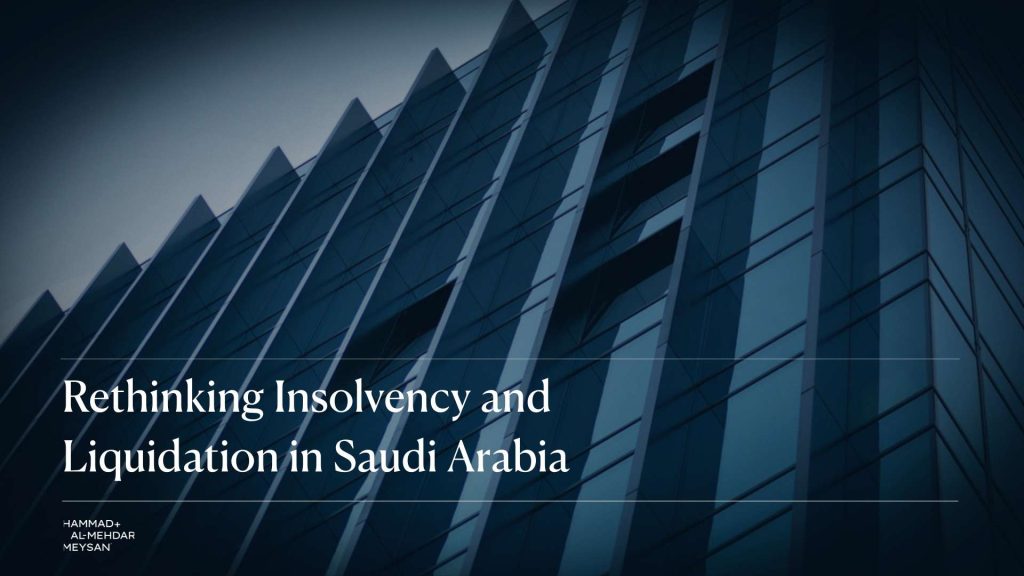
In today’s evolving commercial environment, the concept of business failure is no longer synonymous with stigma or scandal. As Saudi Arabia accelerates its economic transformation, the ability for businesses to restructure, wind down, or exit the market lawfully and transparently has become a critical feature of the Kingdom’s modern legal infrastructure. For business owners, directors, creditors, and foreign investors alike, understanding the legal landscape of insolvency is no longer optional—it is an essential component of risk management.
A Legal Framework Built for Economic Resilience
The introduction of the Saudi Bankruptcy Law in 2018 marked a significant shift in the Kingdom’s approach to managing financial distress. Enacted under Royal Decree No. M/50, the law provided a structured and commercially credible framework for businesses to manage insolvency, preserving economic value and market integrity. Its alignment with global norms—particularly the UNCITRAL Model Law on Cross-Border Insolvency—also signalled Saudi Arabia’s intent to position itself as a globally integrated and investor-friendly jurisdiction.
What sets the Saudi regime apart is its dual focus: it offers tools for early intervention when recovery is possible, and it provides mechanisms for orderly exit where continuation is no longer viable. This flexibility has been crucial in destigmatising bankruptcy and fostering a more proactive, compliance-driven corporate culture.
The Human and Commercial Stakes
For directors and shareholders, insolvency is not just a financial event—it is a test of governance. Saudi law imposes clear duties on company leadership once financial instability is evident. Ignoring warning signs or continuing to operate while insolvent may not only worsen outcomes for creditors but could result in personal liability or sanctions. The role of the Bankruptcy Commission, established under the new regime, is to ensure fairness, transparency, and consistency while holding individuals accountable where negligence or misconduct is identified.
Creditors, meanwhile, have a defined path to recover value through structured repayment hierarchies and legal participation in proceedings. Secured creditors, employees, and government authorities are granted priority; however, even unsecured creditors have a meaningful standing in shaping the outcome of restructuring plans or liquidation terms.
A Tool for Economic Continuity, Not Collapse
Too often, liquidation is viewed as the end of the road. In reality, Saudi Arabia’s legal system treats insolvency as a legitimate—and sometimes even strategic—means of market correction and economic renewal. Whether it involves resolving failed startups, distressed joint ventures, or underperforming family businesses, the law offers mechanisms that protect stakeholders and preserve remaining value.
Smaller entities benefit from simplified procedures that ease administrative burdens. Larger firms can explore supervised restructurings that salvage viable operations. In extreme cases where debts exceed asset value, administrative liquidation ensures a fair and efficient closure with regulatory oversight. This layered system reflects a mature and responsible approach to economic management.
Cross-Border Implications and the Need for Legal Foresight
In an increasingly interconnected Gulf economy, cross-border insolvency poses a significant risk that extends beyond theoretical considerations. Multinational entities, foreign investors, and joint ventures operating in the KSA must be acutely aware of how Saudi law interacts with the legal principles of their home jurisdictions. Recognition of foreign insolvency proceedings, creditor claims from abroad, and the handling of assets across borders are complex but navigable areas, provided legal counsel is engaged early.
From Crisis to Compliance
The reality of doing business includes the possibility of failure, but how that failure is managed can define a company’s legacy, protect reputations, and shape future opportunities. Saudi Arabia’s Bankruptcy Law has laid the groundwork for a responsible, transparent, and modern approach to corporate distress. Yet the law alone is not enough. Business leaders must act early, seek legal advice, and approach distress not as a crisis to be concealed, but as a legal process to be navigated with discipline and foresight.
At HMCO, we advise clients across sectors on strategic responses to financial instability, ensuring their decisions today create options, protections, and clarity for tomorrow.
